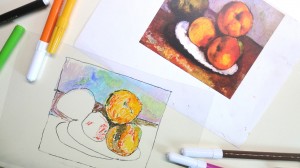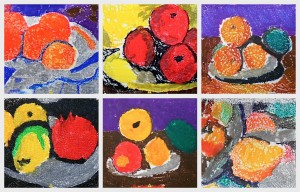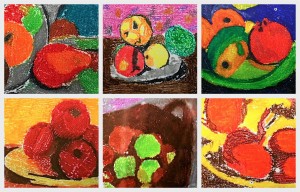Students of Grade 9 have created these little monoprints inspired by Cézanne’s still lives, using transparent acetate sheets as a printing plate. First the acetate sheet was overlaid on picture, then the acetate sheet has been colored with felt tip pens, imitating the colors of Cezanne and mixing the colors together. Subsequently, a sheet of paper has been dampened with a sponge, removing out excess water. The monoprinting plate has been printed on the wet sheet, pressing it with the hand, and so the colors are transferred onto the paper. Have a look to this video tutorial, realized during the lesson
You can also watch the video on YouTube here







What an awesome way to use sheets of acetate, and a new printmaking process, to boot!
Hi Laurel! Yes, it’s very new, simple and effective way to realize printings! I suggest you to try it 🙂
Bravo Miriam! The process is really fun and the monoprints are beautiful. Thanks so much for making the video and sharing it with us.
I thought about the video with my students, because it’s the most effective way to explain the process… Thanks to your comment Rina!
How very cool!! Why did I never think of using acetate for monoprints?!!!
Hi Christie! Was a surprise even for me to discover this technique, so simple, chip and effective! I’m thinking about other works… Do you have any further suggestion? Thanks for your comment 🙂
I just found this video! Love it I have used or reused scraps from school laminator for same type of project. This is great for when it hits a point of year when the scraps run out!
Hi Alyssa, thanks for the comment, I agree! 😉
This is fantastic! I can not wait to share this with my students! Thank you so much!!!!
Hi Debra! I hope you’ll enjoy this technique! 🙂
Hi Miriam,
We use water-soluble crayons (Caran d’Ache brand are beautiful) on pieces of plexi-glass as the plate — can buy them in an art store cut to diff’t sizes. The wet of the paper allows the crayons to look like crayon – watercolour mix when they’re printed. Very nice! We draw with the crayons over the image under the plate — like you do. Laura
Hi Laura! well done! If you like send me a picture to patermir@gmail.com 🙂
Also, we lightly sand the plexi glass plate first, dust off. Then apply a thin layer of gum arabic and let it dry before drawing with the w.s crayons. Laura
(If using a press, then you need to sand the corners of the plate so they’re rounded.)
Wow Laura1 This is a new technique, I’m interested in it! I’m curious!!!
would any pen markers do the job ???
Hi Niveen. You have to do some sample, I used normal felt tip-pens, but the brand is italian and is always better do some tests. 🙂
Great lesson! I am going to try it with a group of middle school and high school homeschool students. Silly question… where do you get the Cezanne example for them to overlay the acetate paper? Do you just print copies from internet? Thanks!
Hi Wendy! yes, I prepare a power point with square details of Cezanne’s paintings, and I print them. I can send you some, If you like, ok? 😉
Hello, this is a great idea for printing. Thank you so much for making it available. I have a couple of questions, what kind of markers did you use for the project? Do you recommend a specific one or any kind of marker? Where can I find Cezanne’s paintings?